Top 40 SOC Analyst Interview Questions
Preparing for a Security Operations Center (SOC) Analyst interview can sometimes feel a bit overwhelming, especially with the wide range of topics you might be asked about. But the good news is, you don’t have to tackle it alone. Whether you’re just beginning your journey into cybersecurity or looking to step into a more advanced role, having a good grasp of common interview questions can really boost your confidence.
Here, we’ve put together a helpful list of frequently asked SOC Analyst interview questions, along with example answers and tips. These can give you a better understanding of what to expect and how to approach each topic thoughtfully and clearly.

What Does a SOC Analyst Do?
A SOC Analyst plays an essential role in an organization’s cybersecurity team. They are the ones keeping a close eye on security alerts, monitoring systems, and responding to potential threats often in real time. Their main goal is to protect the organization’s digital environment, making sure sensitive information stays safe from breaches, cyberattacks, or unauthorized access.
From analysing suspicious activity and investigating incidents to coordinating with other teams for a quick response, SOC Analysts are at the heart of any strong security operation. Their work not only helps prevent data loss and service disruptions, but also builds trust in the organization’s overall security posture.
40 SOC Analyst Interview Questions
General SOC Analyst Interview Question
1. What does the CIA Triad stand for in cybersecurity?
2. What is the difference between IDS and IPS?
3. Can you walk us through your incident response process?
4. What is SIEM, and how have you used it?
5. How do you handle stress in a fast-paced environment like a SOC?
Network SOC Analyst Interview Questions
1. What’s the difference between TCP and UDP?
2. What is a subnet, and why is it used?
3. How would you detect a network-based attack?
4. What is port scanning, and how can it be detected?
5. Can you explain how ARP works?
6. What are some common network vulnerabilities?
Web Application Security SOC Analyst Interview Questions
1. What is SQL injection?
2. What are some ways to prevent cross-site scripting (XSS)?
3. What is CSRF, and how is it mitigated?
4. How do you secure APIs?
5. What is input validation?
6. How do you identify a web application attack in logs?
Cryptography SOC Analyst Interview Questions
1. What’s the difference between symmetric and asymmetric encryption?
2. What is hashing, and how is it used in security?
3. What is a digital signature?
4. What encryption standards are considered secure today?
5. What is SSL/TLS?
6. Can encryption guarantee data integrity?
Event Log Analysis SOC Analyst Interview Questions
1. How do you analyze event logs for suspicious activity?
2. What tools do you use for log analysis?
3. How do you differentiate between false positives and real threats in logs?
4. How do you handle log data retention and compliance requirements?
5. What are critical Windows Event IDs to monitor?
6. How do you respond to suspicious log entries?
Threat Intelligence SOC Analyst Interview Questions
1. What is threat intelligence and why is it important?
2. What are the different types of threat intelligence?
3. What sources do you use for threat intelligence?
4. How do you use threat intelligence in a SOC environment?
5. How do you evaluate the credibility of threat intelligence?
Malware Analysis SOC Analyst Interview Questions
1. What is malware analysis?
2. What are the types of malware analysis?
3. What tools do you use for malware analysis?
4. How do you identify if a file is malicious?
5. How do you respond after identifying malware?
6. What are some common malware evasion techniques?
General SOC Analyst Interview Question
This section includes some of the most common SOC analyst interview questions that test your core understanding of the role. You’ll find questions related to cybersecurity fundamentals, tools used in a Security Operations Center (SOC), and how you handle real-world security incidents. These questions are designed to evaluate your readiness for day-to-day SOC tasks and your ability to think critically in high-pressure environments.
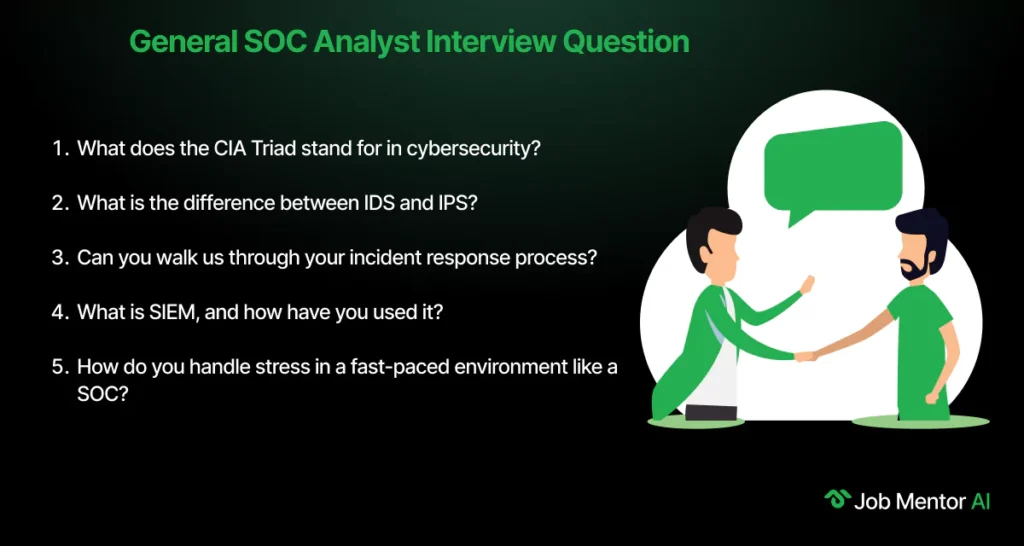
1. What does the CIA Triad stand for in cybersecurity?
The CIA Triad stands for Confidentiality, Integrity, and Availability. It’s a foundational model in cybersecurity that guides policies for securing information.
- Confidentiality ensures that data is accessible only to authorized users.
- Integrity means information is not altered without permission.
- Availability ensures that systems and data are accessible when needed.
For example, when we implemented a new access control system at work, we had to make sure user data was only visible to certain roles (confidentiality), that logs couldn’t be tampered with (integrity), and that the system had uptime monitoring (availability).
2. What is the difference between IDS and IPS?
IDS (Intrusion Detection System) monitors network traffic for suspicious activity and alerts the admin but does not take action. IPS (Intrusion Prevention System) also monitors traffic but actively blocks or prevents detected threats. In one of my projects, we used an IDS to detect brute-force login attempts, but later upgraded to an IPS which blocked the source IP after a set number of failed login attempts. This reduced malicious traffic significantly.
3. Can you walk us through your incident response process?
Sure. The incident response process I follow includes preparation, identification, containment, eradication, recovery, and lessons learned. Once, we identified unusual login activity during off-hours. We immediately contained the user account, ran a full scan of the affected system, removed the malware, and restored clean backups. Post-incident, we updated our detection rules and shared findings with the team.
4. What is SIEM, and how have you used it?
SIEM stands for Security Information and Event Management. It collects and analyzes logs from various sources in real-time. I’ve used tools like Splunk and IBM QRadar to monitor network activity, detect anomalies, and generate reports. At my previous job, I created custom correlation rules in Splunk that helped identify multiple failed logins followed by a successful one, This helped us detect credential stuffing attempts.
5. How do you handle stress in a fast-paced environment like a SOC?
I stay calm under pressure by breaking down problems into smaller tasks, prioritising critical issues first, and communicating clearly with my team. During a DDoS attack simulation, our SOC was under pressure to keep services running. I focused on traffic filtering while others coordinated with ISP and management. Working as a team, we resolved it efficiently and used the event as a learning opportunity.
6. Why do you want to work as a SOC analyst?
I’ve always been passionate about cybersecurity and problem-solving. The dynamic nature of a SOC environment where every day brings new challenges and keeps me motivated. I enjoy working behind the scenes to protect systems and data, and I find it rewarding to investigate alerts, connect the dots, and help prevent larger attacks. My previous internship in threat detection really solidified this interest.
Network SOC Analyst Interview Questions
This section focuses on SOC analyst interview questions related to network security. You’ll be tested on your understanding of network protocols, firewalls, IDS/IPS systems, and how to identify and respond to network-based threats in a SOC environment.
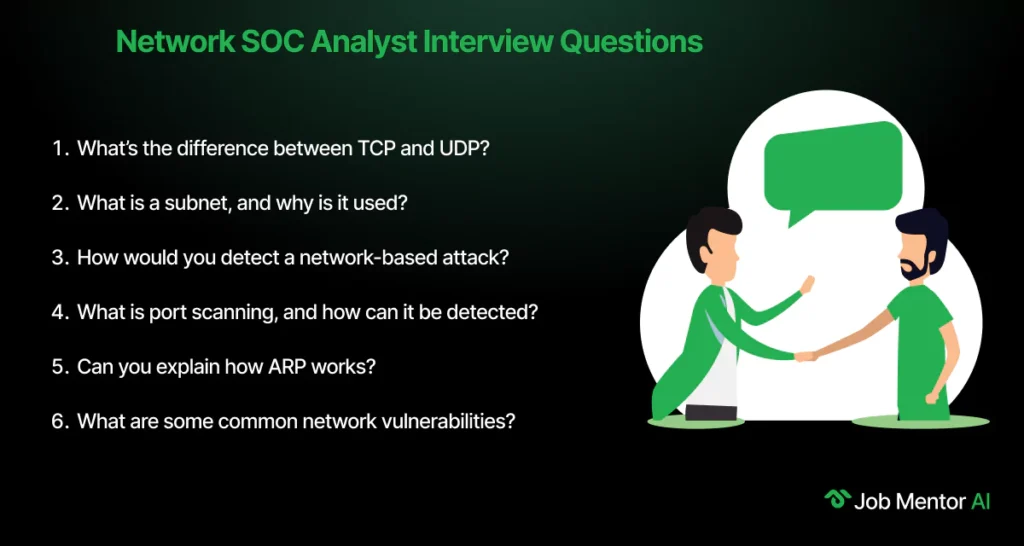
7. What’s the difference between TCP and UDP?
TCP is connection-oriented, meaning it ensures data is delivered reliably and in order. UDP is connectionless and faster but doesn’t guarantee delivery. During a network scan project, I used Nmap to check open TCP ports for stability and used UDP scans to identify services where low latency was key. Understanding both helped us configure firewall rules more precisely.
8. What is a subnet, and why is it used?
A subnet is a segmented piece of a larger network. Subnetting improves performance and security by reducing broadcast domains. When we upgraded our office network, I implemented subnets for HR, IT, and Sales to isolate traffic and apply department-specific access controls. This not only improved performance but also made managing permissions easier.
9. How would you detect a network-based attack?
I look for anomalies in network traffic, such as large data transfers at odd times, unexpected IP connections, or port scanning behavior. Using Wireshark and Splunk, I once identified a data exfiltration attempt where a compromised host was sending sensitive files to an external IP. We blocked the IP, removed the malware, and updated our IDS signatures.
10. What is port scanning, and how can it be detected?
Port scanning is a method attackers use to find open ports and identify services running on a host. It can be detected by looking for multiple connection attempts to various ports from the same IP. I once configured a honeypot to log scanning behavior. The SIEM tool flagged multiple SYN requests across unused ports, which we confirmed as a reconnaissance attempt.
11. Can you explain how ARP works?0
ARP (Address Resolution Protocol) maps IP addresses to MAC addresses in a local network. When a device wants to communicate, it sends an ARP request to find the MAC address. Once, I troubleshooted a network issue where a spoofed ARP reply was redirecting traffic to an attacker’s machine. We implemented dynamic ARP inspection to block such spoofing.
12. What are some common network vulnerabilities?
Common network vulnerabilities include open ports, weak passwords, outdated firmware, unsecured protocols, and misconfigured firewalls. During a network audit, we found a switch with default admin credentials and an exposed management port. Fixing these helped improve our overall security posture.
Web Application Security SOC Analyst Interview Questions
In this part, we cover SOC analyst interview questions that assess your knowledge of web application security. Expect topics like OWASP Top 10, secure coding practices, and detecting application-level attacks through logs and monitoring tools.

13. What is SQL injection?
SQL injection is a code injection technique that attackers use to execute malicious SQL statements. These statements control a web application’s database server. I once identified a vulnerability in a login form during a web audit. By using parameterized queries and input validation, we prevented attackers from accessing sensitive data through SQL injection.
14. What are some ways to prevent cross-site scripting (XSS)?
To prevent XSS, I use input sanitization, encoding user input, implementing CSP (Content Security Policy), and validating all inputs. In one project, we discovered stored XSS in a comment section. We resolved it by escaping all output and applying proper encoding techniques. Regular code reviews and automated scanning were also added to prevent recurrence.
15. What is CSRF, and how is it mitigated?
CSRF (Cross-Site Request Forgery) tricks a user into performing actions on a web app where they’re authenticated. It’s mitigated using CSRF tokens, same-site cookies, and double-submit cookies. Once, we noticed unauthorized profile changes on our platform and mitigated it by enforcing CSRF tokens for all POST requests.
16. How do you secure APIs?
I secure APIs using authentication (OAuth2 or API keys), rate limiting, input validation, and HTTPS. In one of my projects, we added JWT-based authentication and implemented rate limiting to protect the API from abuse and brute-force attacks. We also validated incoming data using JSON schemas.
17. What is input validation?
Input validation ensures that only properly formatted data is accepted. It helps prevent XSS, SQLi, and buffer overflows. In our last e-commerce project, improper input validation led to inventory miscalculations. We fixed it by enforcing strict client- and server-side checks.
18. How do you identify a web application attack in logs?
I look for unusual URL patterns, repeated requests, or payloads containing suspicious characters. Tools like Splunk help visualize this data. Once, I found a pattern where a single IP was attempting to log in with various payloads, indicating a brute-force attempt.
Cryptography SOC Analyst Interview Questions
This section features SOC analyst interview questions that examine your understanding of cryptographic concepts. You’ll be asked about encryption, hashing, digital signatures, and how cryptography supports data confidentiality and integrity.

19. What’s the difference between symmetric and asymmetric encryption?
Symmetric encryption uses one key for both encryption and decryption, while asymmetric encryption uses a public/private key pair. In one system I worked on, we used symmetric encryption for fast data storage encryption and asymmetric encryption for secure key exchange between clients.
20. What is hashing, and how is it used in security?
Hashing converts data into a fixed-size string, often used to store passwords securely or ensure file integrity. I use hashing to compare file states during incident response and to verify downloads. For password storage, we used salted hashes with bcrypt to enhance security.
21. What is a digital signature?
A digital signature verifies the authenticity and integrity of a message or document using asymmetric encryption. It’s widely used in software distribution. I implemented code signing in a DevSecOps pipeline to ensure only verified builds were deployed to production.
22. What encryption standards are considered secure today?
AES-256, RSA-2048 or higher, and ECC are currently considered secure. We adopted AES-256 for encrypting data at rest and TLS 1.3 for data in transit in our latest cloud deployment project to meet compliance requirements.
23. What is SSL/TLS?
SSL and TLS are cryptographic protocols used to secure communications. TLS is the successor to SSL. We upgraded all web services to TLS 1.3, enhancing both security and performance. Certificate management was automated to avoid expiry issues.
24. Can encryption guarantee data integrity?
Encryption doesn’t guarantee integrity by itself—it only hides data. We pair encryption with hashing or use authenticated encryption like AES-GCM. During one audit, we discovered files being tampered with and added HMACs for integrity verification.
Event Log Analysis SOC Analyst Interview Questions
These SOC analyst interview questions test your ability to analyze logs from various systems such as firewalls, servers, and endpoints. You’ll need to identify suspicious behaviour and correlate events to detect security incidents effectively.

25. How do you analyze event logs for suspicious activity?
I start by filtering logs based on time frames, IP addresses, event IDs, and user actions. I look for signs such as failed login attempts, account lockouts, or abnormal access times. In one case, I noticed repeated failed logins followed by a successful one at 3 AM. This led us to investigate a compromised account, disable it, and enforce MFA for all users.
26. What tools do you use for log analysis?
I primarily use Splunk and ELK Stack (Elasticsearch, Logstash, Kibana). In one instance, I used Splunk to correlate VPN login data with Active Directory events. This helped identify a user account that was accessing sensitive files from an unusual IP address, which turned out to be an unauthorised access attempt.
27. How do you differentiate between false positives and real threats in logs?
I verify alerts by correlating logs from multiple sources and checking the context. For example, a single failed login might not be suspicious, but multiple failed attempts followed by a success and unusual file access patterns could indicate a compromise. During one review, what initially seemed like a port scan was actually a vulnerability scanner scheduled by our IT team, which I then whitelisted.
28. How do you handle log data retention and compliance requirements?
Log data retention is handled based on organizational policies and regulatory compliance like GDPR or HIPAA. Typically, critical logs are stored for 1–2 years, depending on the sensitivity. I’ve configured log rotation and archival in Splunk, and used cold storage (like Amazon S3) for long-term retention. We also ensured encrypted storage and access controls were in place.
29. What are critical Windows Event IDs to monitor?
Some key Windows Event IDs include:
- 4624: Successful logon
- 4625: Failed logon
- 4670: Permission changes
- 4688: Process creation
- 4720: User account creation
Monitoring these helps detect suspicious login attempts, privilege escalations, and process anomalies. I set up alerts in Splunk for unusual patterns like multiple failed logons (4625) followed by a successful one (4624).
30. How do you respond to suspicious log entries?
First, I verify the event by checking multiple sources (e.g., endpoint, firewall, VPN logs). If confirmed, I will escalate or initiate containment, like disabling the account or isolating the host. For example, I once found a user account accessing sensitive files outside business hours from a new location. We blocked access, investigated the endpoint, and reset credentials.
Threat Intelligence SOC Analyst Interview Questions
Here, you’ll find SOC analyst interview questions focused on threat intelligence. Questions may cover how to gather threat data, analyze indicators of compromise (IOCs), and apply intelligence to improve threat detection and response.
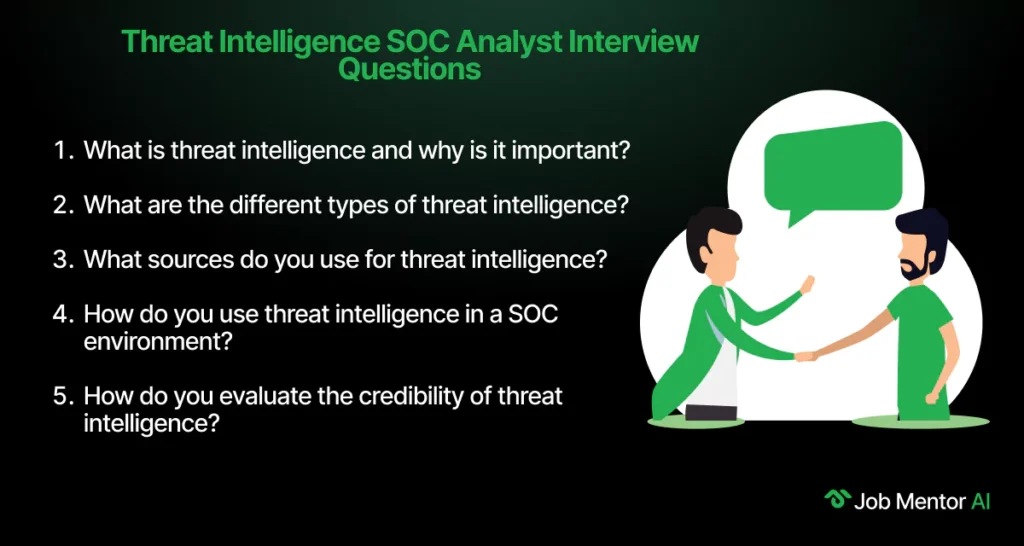
31. What is threat intelligence and why is it important?
Threat intelligence is the process of collecting, analysing, and sharing information about potential or active threats. It helps organizations stay proactive by understanding attacker tactics, techniques, and procedures (TTPs). For instance, we subscribed to threat feeds that alerted us about phishing domains targeting our industry. This helped us block them before any user fell victim.
32. What are the different types of threat intelligence?
The three main types are:
- Strategic – high-level insights for executives, like trends and potential risks.
- Tactical – information about adversary TTPs, useful for defenders.
- Operational – details about specific incoming threats or incidents.
- Technical – indicators like IPs, hashes, or domains.
I once used technical intelligence to block a C2 server IP identified by our upstream provider.
33. What sources do you use for threat intelligence?
I use open-source platforms like AlienVault OTX, MISP, and AbuseIPDB, along with vendor feeds and dark web monitoring tools. In a past project, I integrated data from OTX with our SIEM to automatically alert on IOCs.
34. How do you use threat intelligence in a SOC environment?
We use it to enrich alerts, prioritise incidents, and improve detection rules. For example, when a suspicious domain was flagged in logs, I cross-checked it with threat intelligence sources. It turned out to be a known phishing site, and we immediately blocked it and notified users.
35. How do you evaluate the credibility of threat intelligence?
I verify indicators using multiple trusted sources and correlate them with internal logs. I also consider the source’s reputation, context, and timeliness. In one case, a reported IP was flagged as malicious, but after checking with other feeds and logs, we found it was a false positive from a shared CDN.
Malware Analysis SOC Analyst Interview Questions
This section includes SOC analyst interview questions related to malware detection and analysis. You may be asked about static and dynamic analysis techniques, common malware behaviors, and how to respond to malware infections in a SOC.
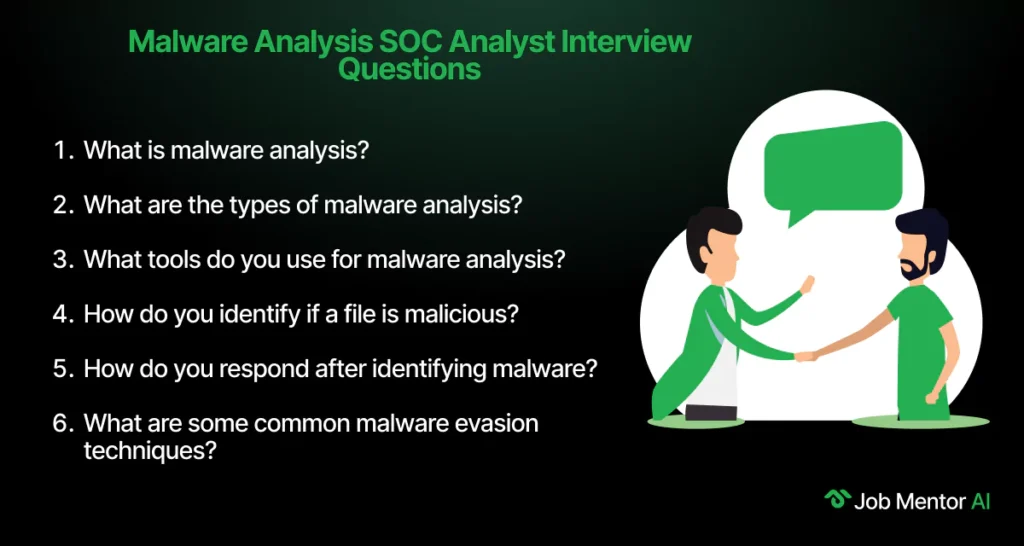
36. What is malware analysis?
Malware analysis is the process of studying malicious software to understand its behaviour, functionality, and indicators of compromise (IOCs). It helps improve detection, response, and prevention strategies. I’ve done basic analysis using sandboxes and static tools to understand how malware communicates with C2 servers.
37. What are the types of malware analysis?
- Static Analysis – inspecting files without execution, e.g., checking file hashes or strings.
- Dynamic Analysis – running the malware in a sandbox to observe behavior.
- Hybrid Analysis – combining both for deeper insight.
I used hybrid analysis on a suspicious file received via email, which helped identify its C2 pattern and payload type.
38. What tools do you use for malware analysis?
I’ve worked with tools like VirusTotal, Any. Run, Cuckoo Sandbox, and PE Studio. For static analysis, I use tools like Exeinfo PE and Strings. For dynamic, I prefer automated sandboxes unless further manual inspection is needed.
39. How do you identify if a file is malicious?
I check hashes against threat databases, examine metadata and strings, and observe its behavior in a sandbox. For example, one file created registry keys and attempted to download a second-stage payload, which clearly indicated malicious intent.
40. How do you respond after identifying malware?
We isolate affected systems, collect IOCs, and remove the malware. Then we conduct a root cause analysis, update our detection rules, and notify stakeholders. Once, a malicious script was spreading through USB drives, so we implemented device control policies and awareness training to stop the spread.
41. What are some common malware evasion techniques?
Common techniques include obfuscation, encryption, anti-VM checks, and code injection. In one case, a macro-based malware delayed execution and checked for sandbox environments to avoid detection. We adjusted our analysis time window to capture its behavior.
5 Key Skills Every SOC Analyst Should Have
Analytical Thinking: Quickly spotting patterns in complex data is crucial for detecting and analyzing threats.
Security Tool Proficiency: Familiarity with tools like SIEMs (e.g., Splunk), IDS/IPS, and endpoint protection helps in timely threat detection.
Networking Basics: Understanding TCP/IP, subnets, and common protocols is vital for identifying network-based threats.
Incident Response: SOC analysts must act quickly and calmly to isolate, investigate, and recover from security incidents.
Continuous Learning: Cybersecurity evolves fast—staying current with tools, threats, and techniques is essential.
Tips to Prepare for a SOC Analyst Interview
- Review Core Concepts: Brush up on the basics like the CIA Triad, IDS/IPS, and SIEM tools.
- Know Your Tools: Get hands-on with tools like Splunk, QRadar, and Wireshark.
- Understand Networking: Review concepts like TCP/IP, subnets, and ARP.
- Prepare for Incident Scenarios: Be ready to walk through your incident response process.
- Stay Updated: Be aware of the latest cybersecurity threats and trends.
Need mock interview practice? Use an AI Mock Interview Practice tool to simulate real interview scenarios and get feedback on your performance.
Questions to Ask in a SOC Analyst Interview
- How does your team handle on-call rotation and urgent incident escalation?
- What SIEM tools and security frameworks does your SOC follow?
- How often does the SOC team participate in red/blue team exercises?
- Are there opportunities to work with threat hunting or threat intelligence teams?
- What kind of professional development or certification support is offered?
Using an AI Questions and Answer Generator can help you frame these and other thoughtful questions, based on your role.
Top 40 SOC Analyst Interview Questions
Table of Contents
Recommended Resources

Top 65 WordPress Interview Questions and Answers 2025

Top 40+ Database Engineer Interview Questions

Game Developer Interview Questions
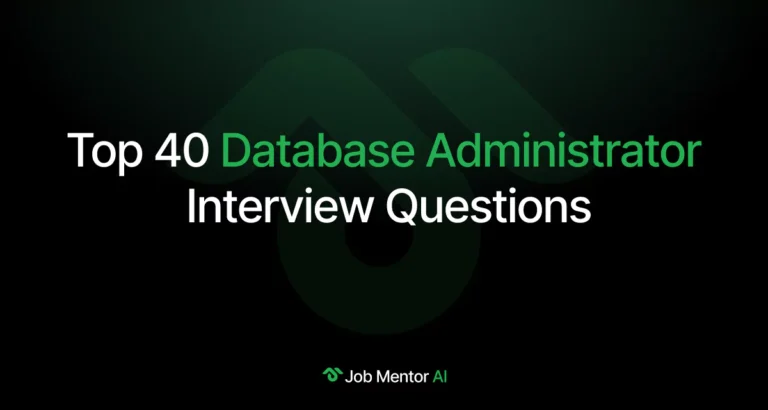
Top 40 Database Administrator Interview Questions

UI/UX Designer Interview Questions

Web Developer Interview Questions


